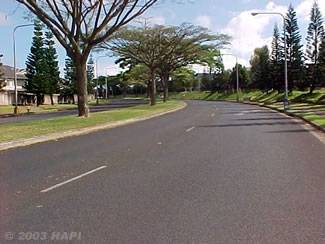Collector Streets
Collector streets connect the residential streets with arterial routes. They may have significant truck and bus traffic and their closure for paving could create substantial commuter delays. Collector street designs can often be applied to rural roads as well.
 |
 |
Figure
1: Collector in Mililani |
Figure
2: Collector in Honolulu |
Assumed Traffic
Low to intermediate speed, moderate traffic volume and some
heavy loadings. Truck traffic can often include substantial
amounts of delivery vehicles, school buses and, sometimes,
public transit buses.
Vehicles per day |
Vehicles per year |
ESALs per year |
|
Cars and Light Trucks |
3,500 |
1,300,000 |
900 |
Medium Trucks and Buses |
100 |
36,500 |
9,000 |
Heavy Trucks and Buses |
20 |
7,000 |
10,000 |
Totals |
3,620 |
1,343,500 |
19,900 |
Design Considerations
Collector street traffic loading can vary widely. High traffic
streets (specifically those with substantially higher heavy
truck and bus traffic levels than those listed above) should
be designed using an approved
structural design procedure.
Construction Considerations
Consideration should be given to paving in two separate
lifts to allow street use with only minimal delays during
construction.
Any localized failures in the first lift can be repaired
before final lift placement.
- American Association of State Highway and Transportation Officials (AASHTO). (1993). AASHTO Guide for Design of Pavement Structures. American Association of State Highway and Transportation Officials. Washington, D.C. (www.aashto.org)
- The Asphalt Institute. (1999). Thickness Design - Asphalt, Manual Series No. 1. The Asphalt Institute. Lexington, KY. (www.asphaltinstitute.org)
- National Asphalt Pavement Association (NAPA). (2001). HMA Pavement Mix Type Selection Guide, Information Series 128. National Asphalt Pavement Association. Landham, MD. (www.hotmix.org)
Recommended Minimum Pavement Thickness and Design (inches)
HAPI Design Checklist • Standard Hawai'i Mixes • Subgrade • Material Substitutions • ACB


